Introduction to the Hebrew Alphabet
The Hebrew alphabet, the holy language of the Bible, is used for biblical Hebrew, Modern Hebrew, Jewish Aramaic, Yiddish, and Ladino. It consists of 22 letters, all consonants, none of which are lowercase. Each letter has its own sound and numerical value. In addition, the presence of a dagesh (a dot placed within a letter to add emphasis) can modify the sound of a letter, essentially making one letter into two; although, how one pronounces these sounds varies. Over the centuries, pronunciation has changed to the point that some communities have lost the distinction between the sounds of certain letters of the Hebrew Alphabet.
The letters and the words they form are holy, with layers of meaning from the literal to the mystical. It was pronounced by G‑d when the Jews received the Torah at Sinai, and it is read from the Torah by Jews all over the world. The Hebrew letters are precise. Every letter and every vowel has a distinct pronunciation. Though some of these distinctions were lost to some communities over the years, they were preserved by other communities.
Click here for a Hebrew Alphabet PDF chart.
The Hebrew alphabet currently appears in three forms:
Block Letters

Block letters are the most ancient of forms, based closely on (and including) the Ktav Ashurit, the calligraphic letters of the Torah and other sacred books. This is the most common form of printed Hebrew. Read more about the history of Ktav Ashurit, as well as another ancient (and no longer practiced) form of Hebrew script called Ktav Ivri.

Rashi Letters
This form of Hebrew was once commonly used as cursive writing and is still used among some Sepharadic Jews. However, it is most commonly used as the preferred typeface for rabbinic commentaries of a more scholarly nature. It is called “Rashi Script,” since it was first introduced (and still widely used) by printers for Rashi’s commentary on the Bible. Read more about Rashi Script.

Hebrew Cursive
Widely used in Israel and the diaspora, Hebrew cursive is like its English counterpart in that it is easy to write but not commonly used in print (other than an occasional headline or advertisement). Unlike English cursive, however, the letters are not attached to each other.

The Hebrew Letters
| Name | Form | Sound | Numerical Value |
| Aleph | א | silent | 1 |
| Beis | בּ | b | 2 |
| Veis | ב | v | 2 |
| Gimel | ג | g | 3 |
| Dalet | ד | d | 4 |
| Hay | ה | h | 5 |
| Vav | ו | v1 or oo | 6 |
| Zayin | ז | z | 7 |
| Khes | ח | kh | 8 |
| Tes | ט | t | 9 |
| Yud | י | y | 10 |
| Kaf | כּ | k | 20 |
| Lamed | ל | l | 30 |
| Mem | מ | m | 40 |
| Nun | נ | n | 50 |
| Samekh | ס | s | 60 |
| Ayin | ע | silent2 | 70 |
| Pay | פּ | p | 80 |
| Fay | פ | f | 80 |
| Tzadi(k) | צ | tz | 90 |
| Kuf | ק | k | 100 |
| Raysh | ר | r | 200 |
| Shin | שׁ | sh | 300 |
| Sin | שׂ | s | 300 |
| Tav | תּ | t | 400 |
| Sav | ת | s | 400 |
Note that the final two letters, tav and sav, were differentiated. This is how it is done by Ashkenazi (European) Jews. In Modern Hebrew, however, they are pronounced as tav, even when there is no dagesh (point) within the letter.
Certain Letters at the End of Words
When appearing at the end of a word, five Hebrew letters change forms. Although they look different, they are still pronounced exactly the same. Here are the final letters:
| Default Name | Default Form | Final Name | Final Form | Sound |
| Khaf | כ | Final Khaf | ך | kh |
| Mem | מ | Final Mem | ם | m |
| Nun | נ | Final Nun | ן | n |
| Fay | פ | Final Fay | ף | f |
| Tzadi(k) | צ | Final Tzadi(k) | ץ | tz |
The Vowels
As noted, the Hebrew letters themselves consist entirely of consonants. Additional symbols (placed below or on top of letters) make vowels, known as nekkudot (dots). These nekkudot make a string of letters into pronounceable and meaningful words. The names of vowels, below, indicate how the nekkudot are pronounced by Ashkenazim as well as by Modern Hebrew speakers, whose accent has been heavily influenced by Sepharadic tradition.

Komatz
Looks like a “T” and can be found under the letter, makes a short “u” sound (as in fun)3

Patach
Looks like a flat horizontal line under the letter and makes an “ah” sound (as in barn)
Note: The Modern Hebrew (Sepharadic) pronunciation for both the komatz and the patach is the sound, “ah.”
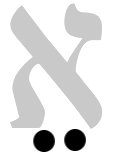
Tzayray
Two side-by-side dots under the letter, makes a long “a” sound (as in day)
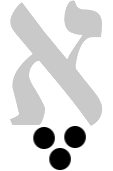
Segol
Three dots arranged as an inverted pyramid under the letter, makes a short “e” sound (as in bed)
Note: The Modern Hebrew (Sepharadic) pronunciation for both the tzayray and the segol is a short “e.”
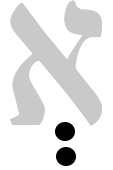
Sheva
Two dots stacked below the letter, can either have no sound at all (this is called a sheva nach) or it can make a quick “ih” sound, as in tick (in which case it is called a sheva na)
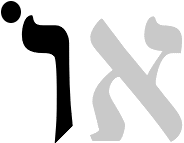
Cholam
Can either make a long “o” sound (as in bone), or among some Ashkenazim it makes an “oy” (as in boy). The cholam can either appear as a dot at the upper left of a letter, or it takes the form of a vav with the dot above it.
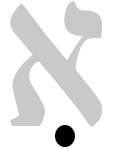
Cheereek
A single dot below the letter, makes a long “e” sound when followed by a yud. Otherwise it makes a short “i” sound.
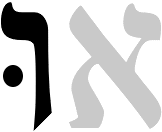
Shoorook
Makes an “oo” sound (like boot) and appears like a vav with a dot to its left
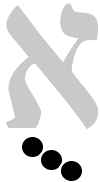
Kubutz
Makes a shorter “oo” sound like in "book" and appears like three dots, arranged like an ascending staircase below the letter
(At times, the komatz, patach and segol may appear with a sheva on their right side. In this case, they are pronounced more briefly, but are known as chataf komatz, chataf patach, and chataf segol.)
Practice your reading with our interactive Hebrew reading trainer.
Gematria (Numerical Value)
In Hebrew every letter has a numerical value. The first 10 letters (aleph to yud) each correspond to a number, one through ten. The next nine letters (khaf to kuf) represent 20 through 100, and the final three letters (raysh, shin and tav) are from 200 to 400. Similar to Roman numerals, letters are added together to equal a given number, and the letters retain their essential worth no matter where they are placed in a sequence, so tav, khaf, and aleph, for example, equal 421. With this system, any word or phrase can be given a specific numerical value, known as gematria. Often, great secrets of the Torah are steeped in gematria. In fact, one of the most popular commentaries on the Torah, written by Rabbi Jacob ben Asher, known as the Baal Haturim, uncovers layers of hidden meaning in the text by way of gematria (and other close analysis of the texts).
Ever wonder why the number 18 in Judaism represents life? The word “life” in Hebrew is pronounced, “Chai,” which is comprised of two letters, “khet” and “yud.” “Khet” represents the number eight, and the letter “yud,” ten. These two letters added together equal 18. “L’Chaim!” To life!
Learn more by reading Everything You Need to Know About Gematria .
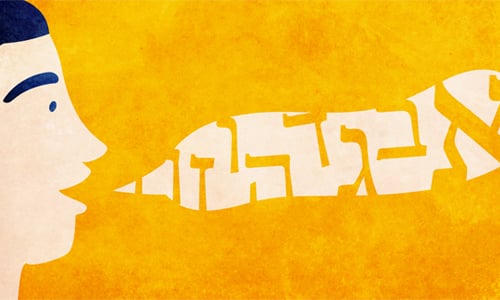
The Code to Creation
The Hebrew letters are not just a handy tool to transcribe Hebrew speech. Rather, they are the vessels through which G‑d created the universe. As told in the opening chapters of Genesis, G‑d spoke ten utterances, and the world came into being. These ten statements are the “garments” through which the Divine energy is translated into physical existence. How about the things, such as computers and books, not mentioned specifically in the ten utterances? That is where gematria and other exchange systems come into play. These allow the Hebrew terms, based on the ten utterances, to “become” the Hebrew name of every given item, which is its life-source.
Learn more by watching KabAlefBet!, a video series on the kabbalistic meaning of the Hebrew letters.






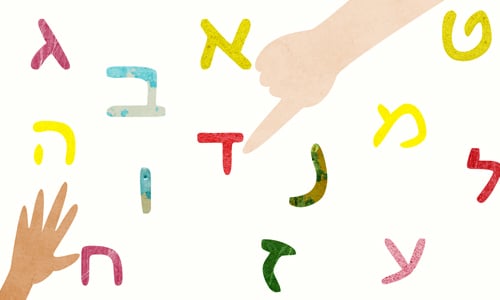

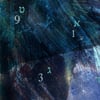
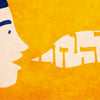
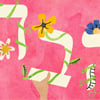
Join the Discussion